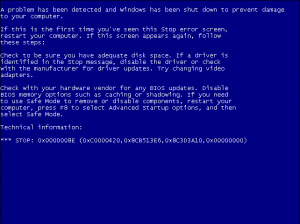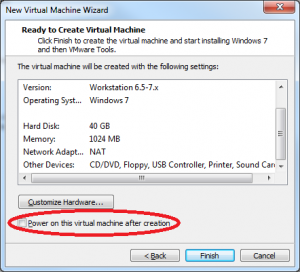The Blue Screen of Death
I was creating a Windows 7 VM using the checked build and during the OS installation process I was treated to the following BSOD: STOP: 0x0000008E (0xC0000420,0x8CB513E6,0x8C3D3A10,0x0000000)

The TLDR Fix
Add the following to the virtual machine’s configuration file (.vmx):
piix4pm.smooth_acpi_timer = "TRUE"
Also, when creating the virtual machine using the “New Virtual Machine Wizard”, be sure to uncheck the box on the last step called “Power on this virtual machine after creation” so that you have the opportunity to edit the vmx file before installation begins.

Digging Deeper
I tried rebooting a few times and each time resulted in BSOD with the same stop code and exception code. The stop code 0x0000008E corresponds to the Bug Check code 0x8E which is KERNEL_MODE_EXCEPTION_NOT_HANDLED. From the MSDN article we can see the 4 values after the stop code are:
- the exception code that was not handled
- the address where the exception occurred
- the trap frame
- and a reserved parameter
Looking in the Ntstatus.h from the WDK we can see that exception code 0xC0000420 is STATUS_ASSERTION_FAILURE.
So why is a checked build of Windows throwing an assertion when installed inside of VMWare Workstation? A quick google searched turned up this recommendation. I was a bit curious as to what the piix4pm.smooth_acpi_timer option was and why an ACPI timer would be causing kernel driver crashes on checked builds but not free builds of Windows. I found this VMWare Knowledge Base article on this issue for Windows Vista and Server 2008 which sheds some light on it. The PIIX4 acronym refers to the Intel PCI ISA IDE Xcelerator (which wikipedia calls the Intel IDE ISA Xcelerator for some reason). From page 2 of this this Intel datasheet:
The 82371AB PCI ISA IDE Xcelerator (PIIX4) is a multi-function PCI device implementing a PCI-to-ISA bridge
function, a PCI IDE function, a Universal Serial Bus host/hub function, and an Enhanced Power Management
function.
It goes on to say (emphasis mine):
PIIX4 supports Enhanced Power Management, including full Clock Control, Device Management for up to
14 devices, and Suspend and Resume logic with Power On Suspend, Suspend to RAM or Suspend to Disk. It
fully supports Operating System Directed Power Management via the Advanced Configuration and Power
Interface (ACPI) specification. PIIX4 integrates both a System Management Bus (SMBus) Host and Slave
interface for serial communication with other devices.
So it appears that the default behavior of the ACPI abstraction in VMWare workstation occasionally violates timer reads which doesn’t play nicely with the hal!HalpGenerateConsistentPmTimerRead assertion in checked builds of Windows. To understand why the guest OS relies on these timer reads and the challenges a virtual machine faces in providing them see “Timekeeping in VMWare Virtual Machines”. The fix is to turn on the smooth_acpi_timer option which I can’t seem to find anymore documentation on.
For what it’s worth, I am running VMware Workstation 7.1.5 build-491717 and using the en_windows_7_debug_checked_build_dvd_x86_398742.iso from MSDN.
Leave a Reply